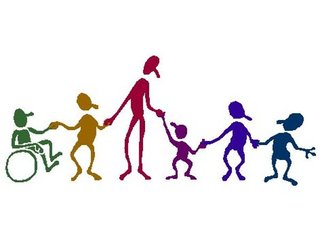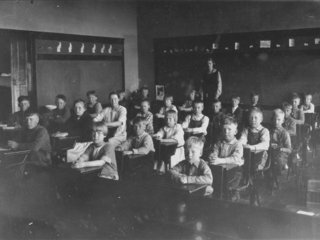
Resetting education: the shift to digital textbooks
There's a world of potential in interactive e-textbooks, but how can schools afford it?

Earlier this year, Education Secretary Arne Duncan and FCC Chairman Julius Genachowski proposed an ambitious goal for K-12 schools across the country: ditch the heavy hard-back textbooks and make the digital switch by 2017. In the next five years, the Obama administration wants to see all K-12 students studying their subject matter not in the traditional sense—with a fat yellow highlighter poised above an open five-pound textbook—but on a tablet or smartphone, where highlighting is done with a swipe of a finger, and notes can be simply copied and pasted by tapping.
Education has been historically slow to adopt new technologies. As Arne Duncan pointed out at Digital Learning Day back in February, we need to be preparing students for an economy of information, but the current school day is built around an agrarian economy—Monday through Friday, nine to five, nine months out of the year. But technology is always on, and the potential for 24-hour access to content is too promising for schools to pass up.
The cost of books
U.S. schools currently spend $7 billion on textbooks, according to Genachowski. And because schools lose anywhere from 5-10% of inventory, they’re likely to overspend by ordering extras. That’s a problem when you consider the fact that schools are already strapped for cash.
K-12 education is the largest expenditure on local and state budgets—across the country, it adds up to $500 billion total. The federal government provides just 9% of that money. The rest comes from the states and local sources. Approximately 27 cents of every dollar collected at the state and local level is going into K-12 education.
When schools find themselves in dire financial straits, they cut their textbook funds. In Sacramento, California, for example, school districts cut their spending on textbooks by 55% between 2008 and 2010. Consequently, teachers end up having to use damaged and out-of-date textbooks.
Can digital textbooks provide the critical cost savings schools are looking for? It seems counterintuitive—how can a school purchase tablets and laptops for all of its students when it can barely afford textbooks? Furthermore, it’s not like digital textbooks are free just because they come in an electronic format. They still cost money. But schools are finding ways to make the digital shift.
A national example: Mooresville, North Carolina
The school district of Mooresville, North Carolina did it. The district has become famous for issuing laptops to all of its 4th through 12th grade students three years ago. It did so by making tough cuts in other areas—notably, its textbook fund, but also jobs. The district laid off 37 teachers. But it also works with Apple to lease MacBooks, and it charges parents $50 a year for computer repairs (those who can’t afford it can waive the fee).
The result: when it comes to dollars spent on each student, Mooresville ranks at number 100 out 115 school districts in North Carolina, spending just over $7,400 per student. The national average is approximately $10,000. But when compared with all of the other districts in North Carolina, Mooresville comes in third in test scores and second in graduation rates. In reading, math, and science, 88% of students met state proficiency standards, compared with 73% three years ago, when the laptops were first issued.
“These devices [like the iPad] allow for interactive learning,” said Julius Genachowski in an interview at Digital Learning Day earlier this year. “If a student’s doing work at home and they get to something they don’t understand, they’re stuck. But with digital textbooks, they can get help right away. They might get stuck and then something will pop up that says, ‘oh, you don’t understand this.’”
The beauty of digital textbooks, as Arne Duncan pointed out, is “rapid feedback and personalized instruction. Kids can tell us what’s working and what’s not working.”
Interactive textbooks
That’s where digital textbook companies like Kno and Inkling come into play. After providing digital textbooks for higher education for the last two years, Kno announced last month that it would begin offering a line of K-12 textbooks in partnership with Houghton Mifflin Harcourt.
Formerly known for its ill-fated attempt to create a single-purpose tablet just for digital textbooks, the company changed course last year and began providing interactive digital textbooks that can be accessed from an iOS device, the Web, or even Facebook.
Kno now offers over 200,000 digital textbooks that come with an array of interactive features, like Quiz Me and the Journal, which allows students to transfer highlighted text, notes, videos, and images over to a digital journal. Other features include automatic flashcards, 3D models, Quiz Me (which automatically turns any diagram into a multiple-choice quiz), SmartLinks that link instructional videos and images within the textbook itself, and a soon-to-be released analytics feature that allows parents to measure their child’s reading progress.
The research behind the features
Kno’s interactive features were not simply thrown into the platform to keep students awake. They’re actually based on the company’s research into what kinds of study habits lead to the best learning outcomes.
“We know that A-grade students use flashcards 71% more than C-grade students,” said CEO Osman Rashid in an interview. “We also know that a C-grade student typically searches a page to find what they’re looking for and spends less than 20 seconds on the page, while an A-grade student spends more time on the page and studying all of the information around the information they were seeking.”
In other words, a student’s understanding of the subject matter depends less on the content itself and more on the way they interact with the content.
To that end, Kno is working with research organizations to figure out how to build interactive features into the content of their digital textbooks in a way that will improve engagement and thus improve a student’s understanding.
“In the ‘90s, every textbook came with a CD in the back, but nobody used it. In the 2000s, every textbook came with URLs, and nobody logged in. We believe the engaging content needs to be brought forth immediately. The assessment tools and videos need to be right there when you need it in the moment when you’re studying.”
The potential for digital textbooks is phenomenal. Right now, many schools are reluctant to allow students to take their books home with them for fear they’ll get lost or damaged. But in a future of digital textbooks, students can read one chapter in class, sync their reading to all their other devices, and then get home and pick up right where they left off on their iPad, iPhone, or on the Web. And what if a teacher could assign a reading and then actually see on a dashboard whether or not (or how much) a student actually read? What if a teacher could see which concepts and terms each student struggled with while avoiding outing the student and embarrassing him?
The hurdles
The possibilities are many—as are the challenges. Currently, one-third of Americans don’t have broadband access. And what about students who don’t have a mobile device, or even a computer at home? Mooresville was able to do issue laptops to each student, but that requires a lot of trust. How do you trust that your students will actually take care of their computers?
Rashid, who is on the commission to find ways to move U.S. schools to digital textbooks, says that there will certainly be government programs to help schools, and some schools might give students devices that they can’t take home. It can be done. In South Korea, print textbooks will be obsolete by 2015. And today in Uruguay, every student is issued a laptop.
“It’s going to take time to move 55 million students over to digital,” said Rashid. “It won’t be overnight.”
Image source: discoveryeducation.com
Related News


Resetting Education: Social networks for the classroom

Resetting Education: The rebounding edtech ecosystem

Resetting Education: tapping into the classroom

Resetting Education: Adaptive learning to the rescue

Resetting Education: The special needs of Special Ed

Resetting Education: How tech is changing the paradigm


